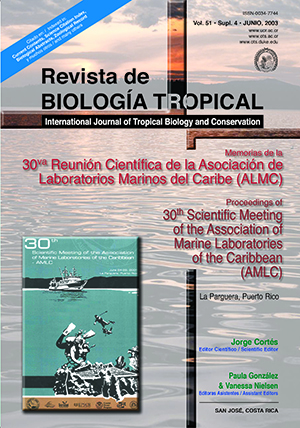Abstract
Coral diseases have been reported as a major problem affecting Caribbean coral reefs. During August 2000, a coral mortality event of White Plague Disease-II (WPD-II) was observed at Madrizqui Reef in Los Roques National Park, Venezuela. This disease was identified as the major cause of coral mortality, affecting 24% of all colonies surveyed (n = 1 439). Other diseases such as Black Band Disease (BBD), Yellow Blotch Disease (YBD), Dark Spots Disease (DSD) and White Band Disease (WBD) were also recorded, but showed a lower incidence (0.140.97%). Two depth intervals, D1 (5.5-6.5 m) and D2 (9-9.5 m) were surveyed with two sets of three band transects 50 x 2 m long, placed parallel to the long axis of the reef. All healthy and injured corals, along each band transect, were counted and identified to species level. Additionally, all diseases and recent mortality that were still identifiable on each colony also were recorded. The incidence of colonies affected by WPD-II ranged from 12.8 to 33% among transects, where thirteen species of scleractinian corals showed several degrees of mortality. The species most affected were Montastraea annularis (39.13%), M. faveolata (26.67%), M. franksi (9.86%), Stephanocoenia intersepta (7.25%), Colpophyllia natans (6.96%), Diploria labyrinthiformis (2.99%), Mycetophyllia aliciae (2.03%), M. cavernosa (1.74%), and D. strigosa (1.45%). WPD-II was more common in the deeper strata (9-9.5 m), where 63% of the surveyed colonies were affected, although the disease was present along the entire reef. Presently, it is imperative to determine how fast the disease is spreading across the reef, how the disease spreads across the affected colonies and what the long-term effects on the reef will be.References
Bruckner, A.W. & R.J. Bruckner. 1997. Outbreak of coral disease in Puerto Rico. Coral Reefs 16: 260.
Bythell, J. & C. Sheppard. 1993. Mass mortality of Caribbean shallow corals. Mar. Poll. Bul. 26: 296-297.
Dustan, P. 1977. Vitality of reef coral populations off Key Largo, Florida: recruitment and mortality. Environ. Geol. 2: 51-58.
Edmunds, P.J. 1991. Extent and effect of black disease on Caribbean reef. Coral Reefs 10: 161-165.
García, A. 2001. Enfermedades y otras anomalías que afectan a los corales escleractínidos en algunas localidades del Parque Nacional Archipiélago de Los Roques. Tesis de Licenciatura, Univ. Central de Venezuela, Caracas, Venezuela. 169 p.
Garzón-Ferreira, J. & M. Kielman. 1993. Extensive mortality of corals in the Colombian Caribbean during the last two decades, p. 247-253. In Proc. Colloq. Global Aspects Coral Reefs: Health Hazards and History. RSMAS, Univ. of Miami.
Gladfelter, W.B. 1982. White-Band disease in Acropora palmata: implications for the structure and growth of shallow reefs. Bull. Mar. Sci. 32: 639-643.
Goreau, T.J., J. Cervino, M. Goreau, R. Hayes, M. Hayes, L. Richardson, G. Smith, K. DeMeyer, I. Nagelkerken, J. Garzón-Ferreira, D. Gil, G. Garrison, E.H. Williams, L. Bunkley-Williams, G. Quirolo, K. Patterson, J.W. Porter & K. Porter. 1998. Rapid spread of diseases in Caribbean coral reefs. Rev. Biol. Trop. 46 (Supl. 5): 157-171.
Green, E.P. & A.W. Bruckner. 2000. The significance of coral disease epizootiology for coral reef conservation. Biol. Conserv. 96: 347-361.
Harvell, C.D., K. Kim, J.M. Burkholder, R.R. Colwell, P.R. Epstein, D.J. Grimes, E.E. Hofmann, E.K. Lipp, A.D. Osterhaus, R.M. Overstreet, J.W. Porter, G.W. Smith & G.R. Vasta. 1999. Emerging marine diseases -climate links and anthropogenic factors. Science 285: 1505-1510.
ISRS. 1999. ISRS statement on diseases on coral reefs. Reef Encounter 25: 24-26.
Porter, J.W. & O.W. Meier. 1992. Quantification of loss and change in Floridian reef coral populations. Amer. Zool. 32: 625-640.
Richardson, L.L. 1998. Coral diseases: what is really know ? Trends Ecol. Evol. 13: 438-443.
Richardson, L.L., W.M. Goldberg, R.G. Carlton & J.C. Halas. 1998a. Coral disease outbreak in the Florida Keys: Plague Type II. Rev. Biol. Trop. 46 (Supl. 5): 187-198.
Richardson, L.L., W.M. Goldberg, K.G. Kuta, R.B. Aronson, G.W. Smith, K.B. Ritchie, J.C. Halas, J.S. Feingold & S.L. Miller. 1998b. Florida's mystery coral-killer identified. Nature 392: 557-558.
Weil, E., I. Urreiztieta, J. Garzón-Ferreira, P. Gayle, D.L. Gil-Agudelo, A. Croquer & S. Zea. 2000. Local and geographic variability in the incidence of diseases in Western Atlantic coral reefs (Abstract), p. 286. In 9th Int. Coral Reef Symp., Indonesia.
Zubillaga, A.L. 2001. Evaluación del efecto de las actividades del buceo recreativo en la estructura comunitaria de algunos arrecifes coralinos del Parque Nacional Archipiélago de Los Roques. Tesis de Licenciatura, Univ. Central de Venezuela, Caracas, Venezuela. 121 p.
##plugins.facebook.comentarios##

This work is licensed under a Creative Commons Attribution 4.0 International License.
Copyright (c) 2003 Revista de Biología Tropical


